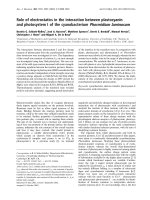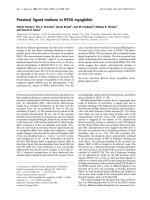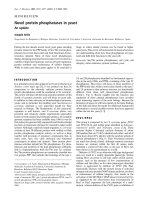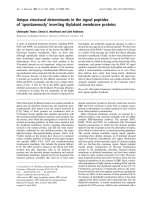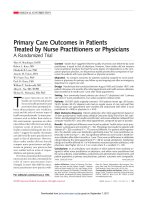Báo cáo y học: "Extracorporeal life support in pediatric cardiac dysfunction" pptx
Bạn đang xem bản rút gọn của tài liệu. Xem và tải ngay bản đầy đủ của tài liệu tại đây (433.82 KB, 5 trang )
RESEA R C H ART I C L E Open Access
Extracorporeal life support in pediatric cardiac
dysfunction
Kasim O Coskun
1
, Sinan T Coskun
2
, Aron F Popov
1*
, Jose Hinz
3
, Mahmoud El-Arousy
2
, Jan D Schmitto
1
,
Deniz Kececioglu
4
, Reiner Koerfer
2
Abstract
Background: Low cardiac output (LCO) after corrective surgery remains a serious complication in pediatric
congenital heart diseases (CHD ). In the case of refractory LCO, extra corporeal life support (ECLS) extra corporeal
membrane oxygenation (ECMO) or ventricle assist devices (VAD) is the final therapeutic option. In the present
study we have reviewed the outcomes of pediatric patients after corrective surgery necessitating ECLS and
compared outcomes with ped iatric patients necessitating ECLS because of dilatated cardiomyopathy (DCM).
Methods: A retrospective single-centre cohort study was evaluated in pediatric pat ients, between 1991 and 2008,
that required ECLS. A total of 48 patients received ECLS, of which 23 were male and 25 female. The indications for
ECLS included CHD in 32 patients and DCM in 16 patients.
Results: The mean age was 1.2 ± 3.9 years for CHD patients and 10.4 ± 5.8 years for DCM patients. Twenty-six
patients received ECMO and 22 patients received VAD. A total of 15 patients out of 48 survived, 8 were discharged
after myocardial recovery and 7 were dis charged after successful heart transplantation. The overall mortality in
patients with extracorporeal life support was 68%.
Conclusion: Although the use of ECLS shows a significantly high mortality rate it remains the ultimate chance for
children. For better results, ECLS should be initiated in the operating room or shortly thereafter. Bridge to heart
transplantation should be considered if there is no improvement in cardiac function to avoid irreversible
multiorgan failure (MFO).
Introduction
Despite technical i mprovements in congen ital heart sur-
gery, mortality as a result of cardiac dysfun ction after
correcti ve surgery remains a serious problem. A total of
1 to 5% of these patients will require some form of
mechanical support [1-3]. In addition, children with
dilatated cardiomyopathy (DCM) may also require extra-
corporeal life support (ECLS) due to multiorgan dys-
function if conservative medical treatment is inadequate.
In this retrospective single center analyzes we present
our experience with both extra corporeal membrane
oxygenation (ECMO) and ventricle assist device (VAD)
for pediatric patients requiring ECLS at our institution.
We reviewed the outcome s of pediatric patients necessi-
tating ECLS after co rrective sur gery and compared
outcomes with pediatric patients necessitati ng ECLS
because of DCM. Our aim is to report the prognosis of
children undergoing ECLS and to compare the out-
comes of the two main diseases associated with high
mortality even in canters with ECLS possibilities.
Materials and methods
A tota l of 48 patients received ECLS, o f which 23 were
male and 25 female. The indications for ECLS included
CHD in 32 cases and DCM in 16 patie nts. The mean
age was 1.2 ± 3.9 years for CHD patients and 10.4 ± 5.8
years for DCM patients. Twenty-six patients received
ECMO; 22 patients in C HD group vs. 4 patients i n
DCM group and 22 patients received VAD; 10 patients
in CHD group vs. 12 patients in DCM group.
The preoperative diagnoses in CHD group included:
14 transposition of the great vessels, 1 Bland-White-
Garland syndrome, 6 tetralogy of Fallot, 2 hypoplasia of
the aortic arch, 2 to tal anomalous pulmonary vein
* Correspondence:
1
Department of Thoracic and Cardiovascular Surgery University of Göttingen,
Göttingen, Germany
Full list of author information is available at the end of the article
Coskun et al. Journal of Cardiothoracic Surgery 2010, 5:112
/>© 2010 Coskun et al; licensee BioMed Central Ltd. Thi s is an Open Access article distributed under the terms of the Creative Commons
Attribution License ( which permits unrestricted use, distribut ion, and reproduction in
any medium, provided the original work is properly cited.
connection, 4 univentricular heart and 3 ventricular sep-
tal defect. Patie nt characteristics are given in Table 1.
Causes of DCM are not reported in this study since
myocardial biopsies was not available in all patients.
Indication for an ECLS is achieved after failing attempts
weaning off from cardiopulmonary bypass (CPB) under
pharmacological support or clinical deterioration and
necessitating resuscitation.
The aim of ECLS initiation was:
• The maintance of systemic circulation
• Recovery of multiple organ failure
• Bridge to transplantation
The patients received an ECLS support in case of:
• Inability to wean from CPB in the operation room
• Clinical deterioration: Despite optimal pharmacologi-
cal support
• Low output syndrome,
• Mean arterial pressure <60 mmHg,
• Ejection fraction <25%
• Cardiac index <2 l/min/kg
• Diuresis <1 ml/min/kg
• Central venous pressure >15 mmHg
• Left atrial pressure > 18 mmHg
Cannulation of ECLS was performed either in the
operating room or in the intensive care unit. The
patient was given 30-100 units/kg of heparin, with
ECMO; the activated clotting time is usually maintained
between 170 and 200 seconds compared to 140-160 sec-
onds in children on VAD. On institution of ECMO, ino-
tropic support was weaned to minimal levels to keep
mean arterial blood pressures at 50 mm Hg. Flow rates
were m aintained depending on hemodynamic situation
until the SVO2 was 75%. The mean blood pressure
range for neonates on ECMO is 40-65 mm Hg. Nor-
mothermia was maintained in all patients. In VAD
group anticoagulation was started 24 hours after
implantation after chest tubes removal Warfarin sodium
(Coumadin; Bristol-Myer Squibb Company, Princeton,
NJ) was initiated to maintain an INR value of 2.5-3.5.
The used devices were MEDOS HIA-VAD (MEDOS
Medizintechnik GmbH, Stollberg, Germany) - a pneu-
matically actuated blood pump, Thoratec paracorporeal
pneumatic V AD (Thoratec Corp, Plesanton, CA), Car-
dioWest total artificial heart (TAH) (SynCardia Systems,
Tucson, AZ, USA). Novacor LVAD (Baxter, O akland,
NJ), ECMO with an oxygenator (Carmeda Maxima;
Medtronic, Düsseldorf, Germany), and ce ntrifugal pump
(Biomedicus; Medtronic). None of the patients had an
intra-aortic balloncounter pulsation (IABP).
Echocardiography is used to evaluate the ventricular
function after 24 hours. Our criteria to initiate a left
VAD-system included: good right ventricular contrac-
tion, adequate oxygenation and right atrial (RA) pres-
sure <12 mmHg. Reducing the flow rate should allow to
maintain adequate left ventricle (LV) ejection with left
atrial (LA) pressure of 8-10 mmHg. If r ight ventricular
(RV) function was poor and if patients did not show
improvement, they should be converted to an ECMO
for better oxygena tion or they received an extra support
like biventricular assist device (BVAD) or right ventricu-
lar assist device (RVAD. In cases of right ventricular
failure, therapeutic measures included volume followed
by nitric oxide inhalation, inotropic agents, phospho-
diesterase type III inhibitors and prostaglandin depend -
ing on hemodynamic situation for each patient
individually [4].
The Indications for BVAD are
• MOF
• cardiac failure
• CVP >20 mmHg
• PAP/CVP gradient < 4 mmHg
• PVR >500 dyn/sec/cm-5
Statistical evaluation
Statistical analysis was performed using commercially
available statistics software (Statistica 5.1., StatSoft Inc.,
Tulsa, OK, USA). Statistics were performed using
Mann-Whitney U test for nonparametric continuous
data and x2-test. Patient survival rates were calculated
according to the Kaplan-Meier life table method (Fig-
ure 1). Statistical difference was considered at p < 0.05.
Results
There was a significant difference in age and weight
between the groups. DCM patients were older (10.4 ±
Table 1 Clinical characteristics
Characteristics DCM
patients
(n = 16)
Congenital
patients
(n = 32)
p-
value
Age at surgery (years) 10.4 ± 5.8 1.2 ± 3.9 0.007
Weight 43 ± 29.2 6.9 ± 13.1 0.0001
Male/female 6/10 17/15 0.30
CPR before ECLS 1 (6.25%) 9 (28.1%) 0.078
CVVH 1 (6.25%) 11 (34.4%) 0.03
HTX 6 (37.5%) 1 (3.13%) 0.001
Bleeding with ECLS 2 (12.5%) 12 (37.5%) 0.07
Pump head exchange 0 5 (15.6%) 0.09
Duration of ECLS (days) 48.5 ± 78.5 7.8 ± 12.1 0.001
Survival after ECLS (days) 563.4 ±
929.4
464.2 ± 848.6 0.58
ECMO
Assist device(LVAD/RVAD/
BVAD)
4 (25%)
12 (75%)
22 (69%)
10 (31%)
0.004
Mortality 12 (75%) 21 (65.6%) 0.50
CPR: cardiopulmonary resuscitation, CVVH: continuous venous-venous
hemofiltration, HTX: heart transplantation, ECLS: extracorporeal life support,
ECMO: extracorporeal membrane oxygenation, LVAD: left ventricle assist
device, RVAD: right ventricle assist device, BVAD: biventricular assist device.
Coskun et al. Journal of Cardiothoracic Surgery 2010, 5:112
/>Page 2 of 5
5.8 vs. 1.2 ± 3.9; p = 0.007) and had more body weight
(43 ± 29.2 vs. 6.9 ± 13.1; p = 0.0001) than c ongenital
patients. Gender achieved no statistically difference
between the groups. Acute renal f ailure, which had to
treated with continuous veno venous he mofiltration
(CVVH), were more frequent in congenital patients than
in DCM patients (11 vs. 1; p = 0.03). I n DCM patients
were more heart transplantations performed than in
congenital patients (6 vs. 1; p = 0.001). Furthermore, the
duration of ECLS was s ignificant longer in DCM
patients than in congenital patients (48.5 ± 78.5 vs. 7.8
± 12.1; p = 0.001). In DCM patients more assist device
(LVAD/RVAD/BVAD) were used and less ECMO than
in congenital patients (p = 0.004). There were no statis-
tically significances observed in bleeding with ECLS,
pump head exchange, and survival after ECLS.
Themortalitywasquiteuniformacrossthegroups
and was analyzed with Logrank test (p = 0.65), as shown
in Figure 1.
Discussion
The general indication for ECLS is inadequate organ
perfusion due to ventricular dysfunction. T he criteria
and guidelines for choosing correct type of ECLS
remains v ariable and controversial since heterogeneous
group of patients are effected whose outcome is greatly
influenced by multiple demographic, anatomic, clinical,
surgical and post operative variables. The selection of
device for the individual patients must be taken in
consideration. The decision to implant an ECLS is based
not only on t he hemodynamic situation, b ut also the
status of organ function. We must take into considera-
tion that many post surgical problems are likely attribu-
table to the preoperative condition of the patient, thus it
is imperative to decide on possible implantation of a
device before multi organ failure occurs. ECLS plays an
important role as an alternative to support patients who
might not otherwise survive - patients with intractable
heart failure, low output or consequent MOF.
Complex C HD corrective operations mostly need
postoperative support some because o f late presentation
and subsequent left ventricular failure, some because of
residual lesions, coronary ischemia, poor myocardial
protection and technical problems. All those factors
increase mortality and need of ECLS. ECMO is more
widely used in the pediatric population for short-term
support and biventricular dysfunction So me authors
confirm that ECMO is superior to VAD in CHD correc-
tive surgery with cyanotic lesions with cardiac shunts,
pulmonary hypertens ion and re spiratory failure, whereas
VAD systems are often indicated for univenticular fail-
ure - for mid to long-term assistance [5,6].
IABP is not adequate for these critical situations; the
optimal approach to preserve end organ function is
instituting VAD or ECMO support before extended per-
iods of LCO, arrhythmia or cardiac arrest.
Renal failure is a predictor of high mortality in VAD
patients. Rapidly deteriorating patients should lead
0 500 1000 1500 2000 2500 3000 3500
100
90
80
70
60
50
40
30
20
Days after ECLS
Number at risk
Group: Congenital
129743111
Group: DCM
85441100
Congenital
DCM
Figure 1 Cumulative survival analysis of both groups as Kaplan-Meier survival function. (Logrank test: p = 0.65).
Coskun et al. Journal of Cardiothoracic Surgery 2010, 5:112
/>Page 3 of 5
physicians to take an aggressive stance toward implanta-
tion of ECLS [2,7,8].
The overall hospital survival for pediatric patients
managed with ECLS ranges between 38% and 53%, with
long-term survival of infants and children at our institu-
tion of 31% (similar to that re ported rates above) [9-17].
Nevertheless, the u se of ECLS has a significantly high
mortality rate associated with cardiopulmonary failure,
multi-organ dysfunction, neurological dysfunction, defi-
ciency of coagulation factors and mechanical factors
[18]. It should be strongly considered that the mortality
in those children ranged up to 90% if they do not
receive any supports [2].
The mechanical complications have an incidence of
27%, including: oxyg enator failure, clots in the cir cuit,
pump malfunction, and presence of air in the circuit.
These complications correspond to long run times [19].
Moreover, ECMO and centrifugal pumps require high
levels of anticoagulation, which increases the risk o f
bleeding. With ECMO, the activated clotting time is
usually maintained between 170 and 200 seconds com-
paredto140-160secondsinchildrenonVAD.There-
fore, bleedin g is the major complication of ECMO, and
the most common sites for bleeding are cannulation and
surgical sites [20].
However, we found that re-exploration for bleeding
did not influence the overall clinical outcome [13].
The importance of brain protection and early identifi-
cation of cerebral injury indicates the importance of
early ECLS initiation. Neurological events in ECLS vary
from 11 to 45% ( 19). Decision on bridging to heart
transplantation, weaning off or device withdrawal
depends on evaluation of neurological events The ELSO
registry data indicated that cardiopulmonary resus cita-
tion (CPR) before the initiation of ECMO does not have
a negative i mpact on outcome, contrarily CPR in the
pre-ECLS period improves survival rates of up to 60%
among neonates [19].
The e stimated weaning rate from ECMO is 43% [21]
and poor prognosis has been reported in patients treated
by ECMO for longer than 8 or 10 days [17,20,22].
Unfortunately high mortality rates are expected in
DCM patients bec ause of lack of heart transplan tation
opportunities, delay in referra l for heart transplantation
and subsequent development of MOF. In c ase of heart
transplantation possibilities the literature shows an
encouraging survival rate over 4 4% in patients bridged
to cardiac transplantation and a 12 month survival of
62% to 88% [17,19,23-26]. In our experience, the appli-
cation of mechanical circulatory support has also been
useful as a bridge to heart transplantation with a survi-
val rate of 71%, which correlates with our previous
paper reviewing the outcome of pediatric heart recipi-
ents with CHD and DCM [26].
It is important to note that this study had some limita-
tions. Although we review ed a relatively large number of
patients between 1991 an 2008, this remains a retrospec-
tive study. A heterogeneous group of patients are affected
whose outcome is greatly influenced by multip le demo-
graphic, anatomic, clinical, surgicalandpostoperative
variabl es. There were data elements, i.e. lactate level, car-
diac biopsy results and echocardiography not available
for the entire cohort. Furthermore, a complete neurologi-
cal evaluation was not always available, thus embolic or
ischemic cerebrovascular events were not analyzed.
Conclusion
ECMO and V AD remains the mainstay of mechanical
circulatory support for children. The progress and devel-
opment of ECLS is on-going and may possibly, in the
near future, become a m ore effective and rapid support
treatment option. ECMO, rather than VAD, may
become the first line of treatment of choice - with faster
initiation and fewer complications. For better results,
ECLS should be init iated in the operating room or
shortly thereafter to avoid prolonged hypoperfusion and
a catastrophic cardiac arrest. Howe ver, if there is no
improvement in cardiac function, than patients should
be bridged to VAD or heart transplantation.
Author details
1
Department of Thoracic and Cardiovascular Surgery University of Göttingen,
Göttingen, Germany.
2
Department of Cardiovascular Surgery, Heart and
Diabetes Centre North-Rhine Westphalia, Ruhr-University of Bochum, Bad
Oeynhausen, Germany.
3
Department of Anaesthesiology, Emergency and
Intensive Care Medicine, University of Göttingen, Göttingen, Germany.
4
Department of Pediatric Cardiology, Heart and Diabetes Centre North-Rhine
Westphalia, Ruhr-University of Bochum, Bad Oeynhausen, Germany.
Authors’ contributions
OC, SC, and ME and had helped with surgical techniques, performed data,
analysis, statistics, graphics, and wrote the paper. AP and JS and helped with
data interpretation and helped to draft the manuscript. DK and RK co-wrote
the manuscript and added important comments to the paper. All authors
read and approved the final manuscript.
Competing interests
The authors declare that they have no competing interests.
Received: 29 June 2010 Accepted: 17 November 2010
Published: 17 November 2010
References
1. Raithel SC, Pennington DG, Boegner E, Fiore A, Weber TR: Extracorporeal
membrane oxygenation in children after cardiac surgery. Circulation
1992, 86:305-310.
2. Duncan BW, Hraska V, Jonas RA, Wessel DL, Del Nido PJ, Laussen PC,
Mayer JE, Laperre RA, Wilson JM: Mechanical circulatory support in
children with cardiac disease. J Thorac Cardiovasc Surg 1999, 117:529-42.
3. del Nido PJ, Armitage JM, Fricker FJ, Shaver M, Cipriani L, Dayal G, Park SC,
Siewers RD: Extracorporeal membrane oxygenation support as a bridge
to pediatric heart transplantation. Circulation 1994, 90:66-669.
4. Warnecke H, Berdjis F, Hennig E, Lange P, Schmitt D, Hummel M, Hetzer R:
Mechanical left ventricular support as a bridge to cardiac
transplantation in childhood. Eur J Cardiothorac Surg 1991, 5:330-333.
Coskun et al. Journal of Cardiothoracic Surgery 2010, 5:112
/>Page 4 of 5
5. Duncan BW, Hraska V, Jonas RA: Mechanical circulatory support for
pediatric cardiac patients. Circulation 1996, 94:173.
6. El-Banayosy A, Arusoglu L, Kleikamp G, Minami K, Körfer R: Recovery of
organ dysfunction during bridging to heart transplantation in children
and adolescents. Int J Artificial organs 2003, 26(5):395-400.
7. Reiss N, El-Banayosy A, Arusoglu L, Blanz U, Bairaktaris A, Koerfer R: Acute
fulminant myocarditis in children and adolescents: the role of
mechanical circulatory assist. ASAIO J 2006, 52:211-214.
8. Farrar DJ, Hill JD, Pennington DG, McBride LR, Holman WL, Kormos RL,
Esmore D, Gray LA Jr, Seifert PE, Schoettle GP, Moore CH, Hendry PJ,
Bhayana JN: Preoperative and postoperative comparison of patients with
univentricular and biventricular support with Thoratec ventricular assist
device as a bridge to cardiac transplantation. J Thorac Cardiovasc Surg
1997, 113:202-209.
9. Karl TR, Horton SB: Options for mechanical support in pediatric patients,
in Goldstein DJ, Oz MC (eds), Cardiac assist devices. Armonk, NY: Futura;
2000, 37-62.
10. Jaggers JJ, Forbess JM, Shah AS, Meliones JN, Kirshbom PM, Miller CE,
Ungerleider RM: Extracorporeal membrane oxygenation for infant
postcardiotomy support: significance of shunt management. Ann Thorac
Surg 2000, 69:1476-83.
11. Reinhartz O, Stiller B, Eilers R, Farrar DJ: Current clinical status of pulsatile
pediatric circulatory support. ASAIO J 2002, 48:455-459.
12. Kolovos NS, Bratton SL, Moler FW, Bove EL, Ohye RG, Bartlett RH, Kulik TJ:
Outcome of pediatric patients treated with extracorporeal life support
after cardiac surgery. Ann Thorac Surg 2003, 76:1435-42.
13. Huang SC, Wu ET, Chen YS, Chang CI, Chiu IS, Chi NH, Wu MH, Wang SS,
Lin FY, Ko WJ: Experience with extracorporeal life support in pediatric
patients after cardiac surgery. ASAIO J 2005, 51(5):517-21.
14. Taylor AK, Cousins R, Butt WW: The long term outcome of children
managed with extracorporeal life support: an instutional experience. Crit
Care Resusc 2007, 9:172-177.
15. Fisher JC, Stolar CJH, Cowles RA: Extracorporeal membrane oxygenation
for cardiopulmonary failure in pediatric patients: Is a second course
justified? J Surgical Research 2008, 148:100-108.
16. Fraizer EA, Faulkner SC, Seib PM, Harrell JE, Van Devanter SH, Fasules JW:
Prolonged extracorporeal life support for bridging to transplant:
technical and mechanical considerations. Perfusion 1997, 12:93-98.
17. Lequier L: Extracorporeal life support in pediatric and neonatal critical
care: a Review. J Intensive Care Med 2004, 19:243-258.
18. Black MD, Coles JG, Williams WG, Rebeyka IM, Trusler GA, Bohn D,
Gruenwald C, Freedom RM: Determinants of success in pediatric cardiac
patients undergoing extracorporeal membrane oxygenation. Ann Thorac
Surg
1995, 60:133-138.
19. Sharma MS, Webber SA, Morell VO, Gandhi SK, Wearden PD, Buchanan JR,
Kormos RL: Ventricular assist device support in children and adolescents
as a bridge to heart transplantation. Ann Thorac Surg 2006, 82(3):926-32.
20. Zhao J, Liu J, Feng Z, Hu S, Liu Y, Sheng X, Li S, Wang X, Long C: Clinical
outcomes and experience of 20 pediatric patients treated with
extracorporeal membrane oxygenation in Fuwai Hospital. ASAIO J 2008,
54(3):302-5.
21. Borowski A, Korb H: Experience with uni- (LVAD) and biventricular
(ECMO) circulatory support in postcardiotomy pediatric patients. Int J
Artif Organs 1997, 20:695-700.
22. Kulik TJ, Moler FW, Palmisano JM, Custer JR, Mosca RS, Bove EL, Bartlett RH:
Outcome-associated factors in pediatric patients treated with
extracorporeal membrane oxygenator after cardiac surgery. Circulation
1996, 94:63-8.
23. Gajarski RJ, Mosca RS, Ohye RG, Bove EL, Crowley DC, Custer JR, Moler FW,
Valentini A, Kulik TJ: Use of extracorporeal life support as a bridge to
pediatric cardiac transplantation. J Heart Lung Transplant 2003, 22:28-34.
24. Coskun O, Parsa A, Weitkemper H, Blanz U, Coskun T, Sandica E,
Tenderich G, El-Banayosy A, Minami K, Körfer R: Heart transplantation in
children after mechanical circulatory support: comparison of heart
transplantation with ventricular assist devices and elective heart
transplantation. ASAIO J 2005, 51(5):495-7.
25. Coskun KO, Popov AF, Coskun ST, Blanz U, Bockhorst K, El Arousy M,
Weitkemper HH, Hinz J, Schmitto JD, Körfer R: Extracorporeal life support
in pediatric patients with congenital heart diseases-outcome of a single
center. Minerva Pediatr 2010, 62(3):233-8.
26. Coskun O, Parsa A, Coskun T, El Arousy M, Blanz U, Von Knyphausen E,
Sandica E, Tenderich G, Knobl H, Bairaktaris A, Kececioglu D, Köerfer R:
Outcome of heart transplantation in pediatric recipients; experience in
128 patients. ASAIO J 2007, 53(1):107-10.
doi:10.1186/1749-8090-5-112
Cite this article as: Coskun et al.: Extracorporeal life support in pediatric
cardiac dysfunction. Journal of Cardiothoracic Surgery 2010 5:112.
Submit your next manuscript to BioMed Central
and take full advantage of:
• Convenient online submission
• Thorough peer review
• No space constraints or color figure charges
• Immediate publication on acceptance
• Inclusion in PubMed, CAS, Scopus and Google Scholar
• Research which is freely available for redistribution
Submit your manuscript at
www.biomedcentral.com/submit
Coskun et al. Journal of Cardiothoracic Surgery 2010, 5:112
/>Page 5 of 5


